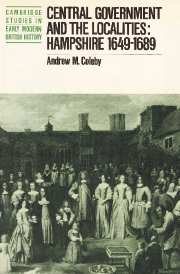Book contents
- Frontmatter
- Contents
- List of maps
- Acknowledgements
- List of abbreviations
- INTRODUCTION AND PROLOGUE
- PART I THE INTERREGNUM
- PART II THE RESTORATION
- THE RESTORED MONARCHY AND THE ROLE OF GOVERNMENT
- 4 LOCAL OFFICE-HOLDING 1660–78
- 5 THE ENFORCEMENT OF POLICY 1660–78
- 6 COURT AND COUNTY 1660–78
- PART III FROM THE POPISH PLOT TO THE REVOLUTION OF 1688
- EPILOGUE AND CONCLUSION
- Bibliography
- Index
4 - LOCAL OFFICE-HOLDING 1660–78
Published online by Cambridge University Press: 14 October 2009
- Frontmatter
- Contents
- List of maps
- Acknowledgements
- List of abbreviations
- INTRODUCTION AND PROLOGUE
- PART I THE INTERREGNUM
- PART II THE RESTORATION
- THE RESTORED MONARCHY AND THE ROLE OF GOVERNMENT
- 4 LOCAL OFFICE-HOLDING 1660–78
- 5 THE ENFORCEMENT OF POLICY 1660–78
- 6 COURT AND COUNTY 1660–78
- PART III FROM THE POPISH PLOT TO THE REVOLUTION OF 1688
- EPILOGUE AND CONCLUSION
- Bibliography
- Index
Summary
It is the object of this section to explore the impact of the Restoration upon local office-holding and the structure of local patronage in Hampshire, drawing some comparisons with the 1650s. The Restoration government stood in a very different relationship with the provinces from its Interregnum predecessors. With the wide support of the landed classes, it lacked the incentive to use patronage to win over enemies. There was considerable freedom of choice over who was appointed. But the government was also heir to the partisan attitudes engendered by the Civil War, and was just as interested in the loyalty of local office-holders as its Interregnum predecessors had been.
The Restoration government, even before the election of the Cavalier Parliament, tended to rely on men of proven loyalty, and in many cases with royalist pasts, to perform important tasks in Hampshire. The lieutenancy was a more compact, more carefully hand-picked, and no less partisan body than the militia commissioners of the 1650s. Lord Treasurer Southampton, the lord lieutenant, was one of the more conciliatory of former royalists, but four out of his six deputies had been active royalists, and the fifth was the son of a royalist. Richard Norton was the isolated, one is tempted to say token, former parliamentarian. The same partisan spirit is discernible in the appointment of officers.
- Type
- Chapter
- Information
- Central Government and the LocalitiesHampshire 1649-1689, pp. 89 - 103Publisher: Cambridge University PressPrint publication year: 1987

